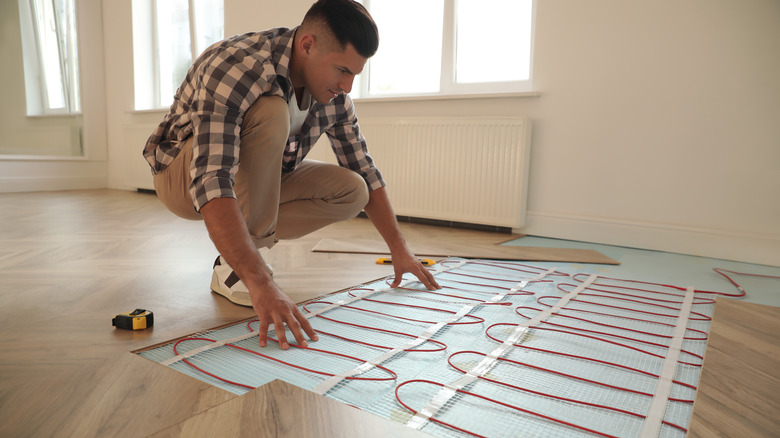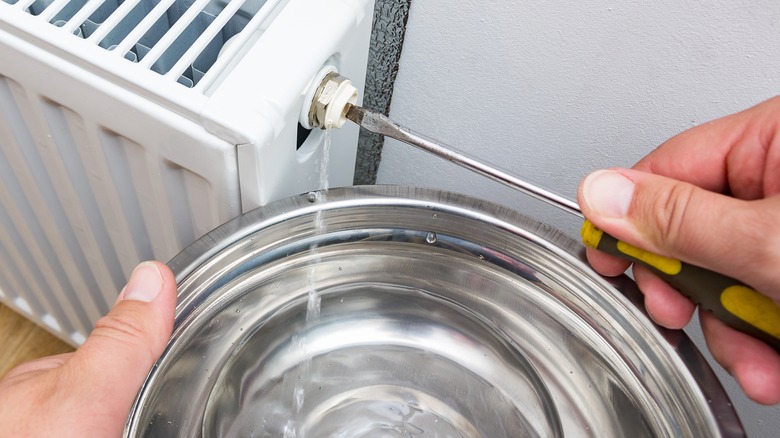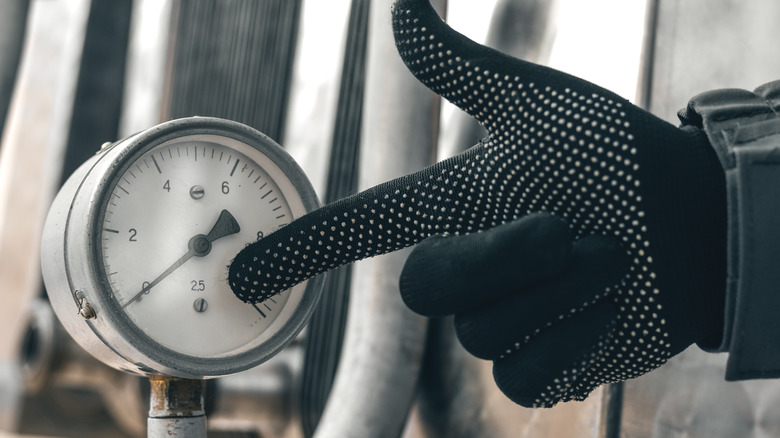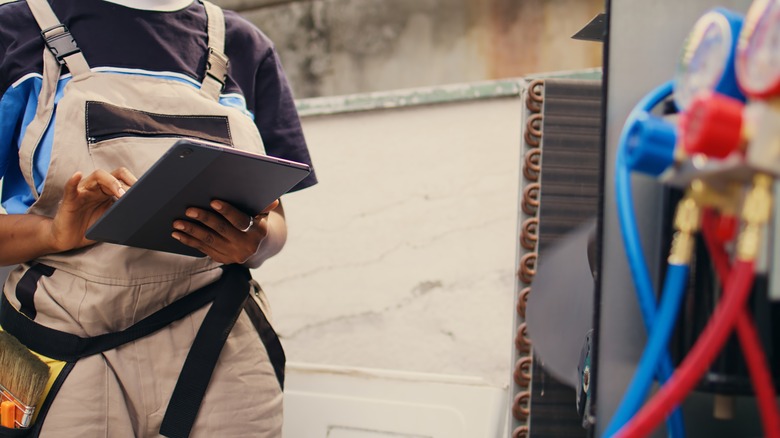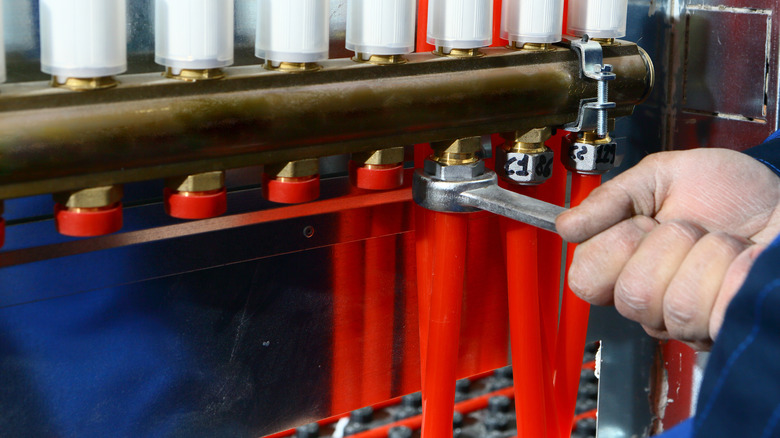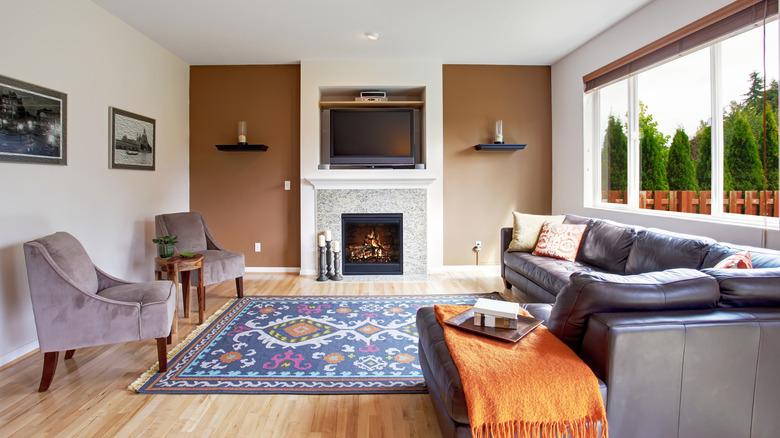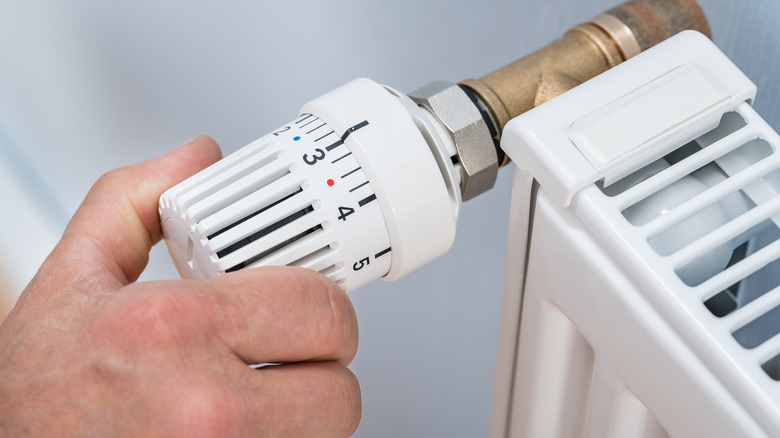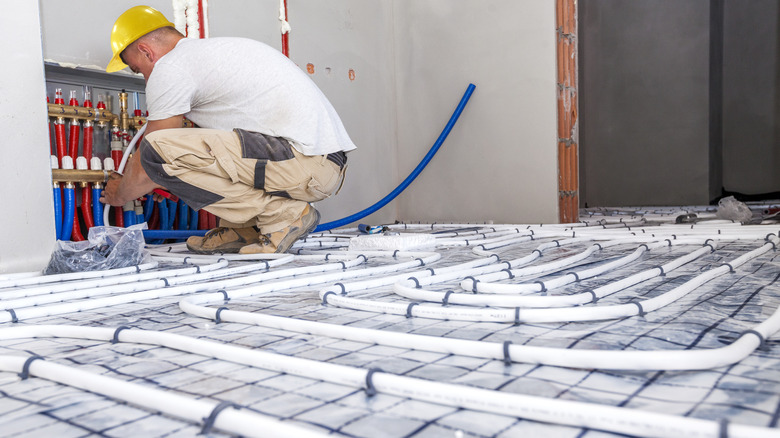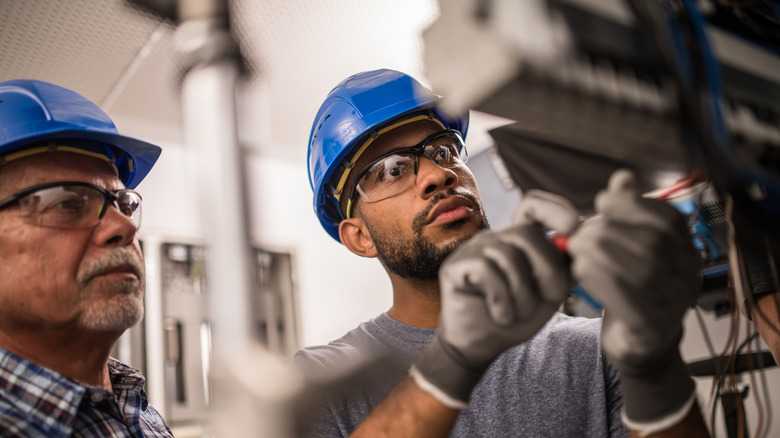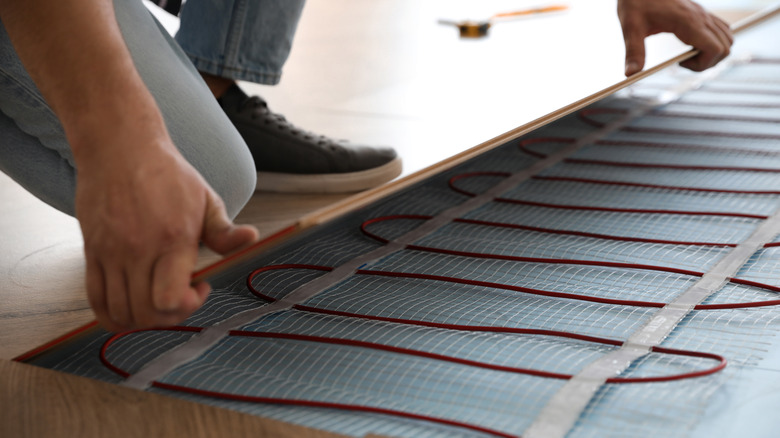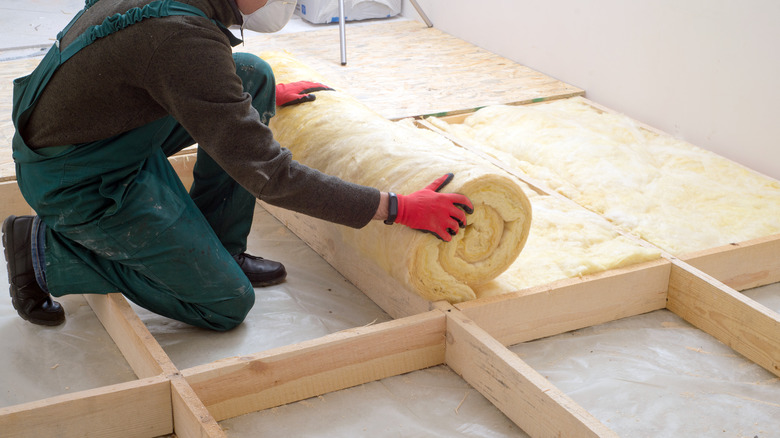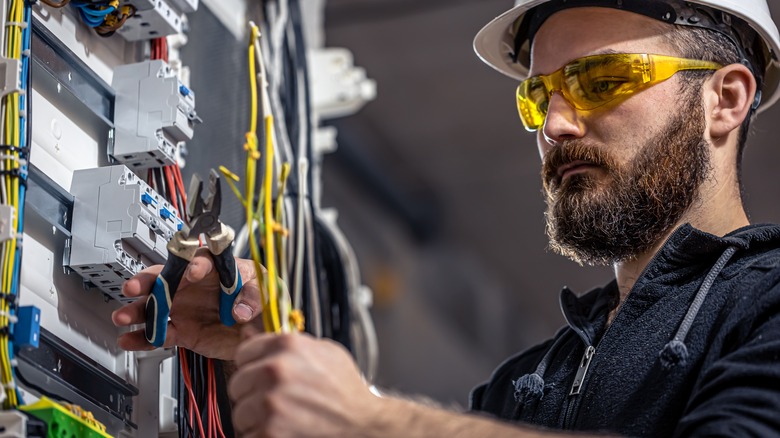13 Reasons Why Your Radiant In-Floor Heating Isn't Working (And How To Fix It)
With radiant in-floor heating, your feet will touch a warm, inviting surface whenever you walk around your home. Yet, despite the promise of offering a comfort level that traditional systems struggle to match, your in-floor system may be stubbornly cold and uninviting. A range of underestimated or overlooked issues can make your heating not work correctly, resulting in cold spots.
While mechanical failures are the root cause of many in-floor heating problems, issues with maintenance, installation, and everyday household practices can also play a part. For example, issues with your thermostatic radiator valves may lower the heat output if they malfunction, get stuck, or set too low, and it's an issue that is relatively easy to miss. Faulty wiring or blocked pipes are also common, and these are slightly more complex fixes that may require you to call a professional to help.
From simple to complex, you can empower yourself by knowing the common reasons your radiant-in-floor heating isn't working and how to fix it. It's not all about quick fixes, though. It's about ensuring your system delivers the heat you need to feel comfortable and avoiding the common problems that can lead to increased energy bills, cold spots, and expensive repairs.
You're having thermostat issues
Think of the thermostat as your radiant in-floor heating's brain that tells the system how much heat it should send through your floors and when. If it's not working or calibrated correctly, it won't be able to send out these signals properly, leaving your floors cold when you need them to be warm. Dead batteries, outdated software, or internal damage could all contribute to this problem. If your thermostat isn't working correctly, it won't activate the heating system or keep the correct temperature, and this can negatively impact how comfortable you are in your home.
Start simple to figure out what's going on with your radiant in-floor heating thermostat. First, double-check the thermostat's settings to ensure they are programmed correctly to meet your heating needs. You may have to adjust the settings to match your ideal comfort levels. Look at the batteries too because dead or dying batteries can make the thermostat fail. If you replace them and still have issues, recalibrating the system is the next step. You want to ensure it can read and regulate the temperature accurately. You'll want to look at the manufacturer's instructions to do this because they can vary, and you may have to replace the thermostat if none of these fixes work.
There is air in the system
When air enters your radiant in-floor heating system, it forms a barrier, so the hot water has trouble flowing freely through the pipes under your floor. Getting air trapped will make your system not heat as well. The water will try to flow through the pipes and spread an even warmth across the floor, but it'll run into air pockets that stop it. In return, you'll end up with cold spots and uneven heating, and your system will work much harder than necessary to keep things comfortable and warm. Even though you may think getting air in your system is minor, it can be a massive roadblock to how well your system works.
To get your radiant in-floor heating back to peak performance levels, you'll have to get the trapped air out of the pipes. You do this through a process called "bleeding" the system, and you can usually do this yourself without having to call in a professional. Find the bleed valves on the radiators or the main pipeline. Open these valves to let the trapped air out when you find them. You should hear a hissing sound as it escapes, and it's common to see water. Continue this bleeding process until you work through all the valves and remove all the trapped air to get your system running properly again.
The water pressure is low
If the water pressure in your home is low, it can impact how well your in-floor heating system circulates hot water, and this can cause cold spots or lukewarm floors. Low water pressure can have many root causes, like internal leaks, including in the piping under the floor or at the connection points. Recent maintenance projects that could have caused you to drain the system are another cause. If you don't refill it when you finish your project, it can't move the heated water smoothly, making it less reliable. Figuring out the root cause of the low pressure is critical for restoring your system.
To determine if low water pressure is behind your radiant in-floor heating issue, first look for any visible signs of leaks. Check every accessible pipe and connection. You should also check the boiler to see if you can spot any dampness or pooling water. If you find leaks, your next step is to repair them by replacing the damaged piping pieces or tightening the connections. Once you fix the leaks, carefully refill your system to get the water pressure up to the manufacturer-recommended level. This usually means you'll open the filling valves on your boiler or the main system until the pressure gauge hits the desired level. If you're unsure how to do this, contacting a professional for help is your next step.
The pump is faulty
The circulation pump is the heart of your radiant in-floor heating system. It's the part that moves hot water from the boiler through the pipe network under your flooring to ensure every part gets heated to the appropriate level. When this pump breaks down or malfunctions, it causes issues with the heating process. A faulty pump could be the result of general wear and tear, electrical issues, or mechanical failure. The leading indicators that you have a problem with your pump include odd noises coming from the pump, your system no longer heating, or your system not heating evenly. If the pump fails, the hot water can't circulate through the pipes, leaving cold sections.
To determine if the pump is the problem, look at it and see if you can spot any obvious signs of damage or wear. Listen for noises, like whirring or grinding, as this could indicate mechanical issues. Check and see if the pump feels hot to the touch because this could signal an electrical problem or a blockage. If the pump stops working, replace it by shutting off the power to your system for starters. When it's off, carefully drain any water from around the pump and remove it. Replace it with a new pump that matches the current one's specifications.
The zone control valves are stuck closed
Your zone control valves help regulate the water flow in different zones or areas of your home, allowing you to customize your temperature settings in each zone. However, if these valves get stuck in the closed position, they block hot water from entering the pipes in specific areas, keeping the floor cold. Sediment buildup, a lack of use, or corrosion can all make these valves get stuck or jam. As a result, some parts of your floors stay cold while others are warm, and figuring out that specific zones don't heat like others is a massive indicator that these valves are behind the problem.
To fix stuck zone control valves, manually open them by twisting or turning the valve handle or lever to the open position, depending on the heating system's design. If the valve refuses to move or you can't change the position, it is most likely seized, and you must replace it. However, before you replace it, ensure your heating system is off, and the area around the valve is safe. Replacing this valve usually involves removing it from your system and installing a new one, ensuring you get a secure fit. If you're not experienced with working on plumbing and heating systems, or if the floor doesn't heat after you try to force the valve open manually, call in a professional. Zone valves cost between $100 and $300, not counting labor.
The system doesn't heat the space correctly
When your in-floor heating doesn't heat the floor as it should, you may be able to trace the problem back to the original design. A system that doesn't have the proper design may end up with insufficient heating coverage or fall short of the necessary capacity to warm the whole floor. This could come from design flaws, like undersized tubing, incorrect heating element spacing, insufficient insulation, or a boiler that can't keep up with the water needs for a bigger space. Each of these problems could mean that your system works, but it can't meet your home's heating demands, leading to cold spots, uneven temperature, or an inability to keep the floor to the desired temperature.
This is a very complex fix that requires a professional. Talking with a heating and cooling company will give you an idea of the project's scope and how much it'll cost to fix. Professionals will be able to evaluate your current setup to see if the system is powerful enough to meet your heating needs, check for installation errors, and recommend upgrades or adjustments. This project could entail minor adjustments or a complete overhaul, and the price will depend on the area's size and what needs to get fixed. Fixing your issue could cost between $90 and $1,200 or more. If a company has to open the walls or lift the floors, the price can easily top $10,000.
You have a problem with thermal blocking
Many people put rugs down to keep their homes warmer during winter, but it can cause thermal block with radiant in-floor heating. Thermal blocking happens when large area rugs or furniture get in the way of the heat flow from your in-floor system, and it can cause uneven heating across your zones. The heat intended to evenly warm the room gets trapped under the rugs or furniture, stopping it from circulating correctly. Some areas are comfortable while others are cool, and having denser, thicker rugs or furniture may worsen this issue. Recognizing that where you put these items on your floor can affect heating performance is crucial in addressing uneven warmth and achieving a comfortable, evenly heated environment.
To fix thermal blocking, look at your room's layout and determine if you have any rugs or furniture right above the in-floor heating system. If there are, consider rearranging these items. Removing your large area rugs altogether can also improve how well the heat circulates. You may need to swap them out with hessian-backed options or rugs with low thermal resistance, as there are rug types to avoid on heated floors. For the best aesthetic results, find a balance that keeps your space cozy without impacting your system.
Your thermostatic radiator valves (TRVs) are set too low
Thermostatic Radiator Valves (TRVs) control the individual radiator temperatures, including the temperature of the room they're in. If you set them too low, they limit how much hot water goes through the radiator, lowering the total heat output and causing the room to feel cooler. This is a problem during the colder months when you need it warmer. Also, they may not work correctly due to age, general wear and tear, or an internal part failure. TRVs are also sensitive to their settings and the room's ambient temperature, meaning a tiny adjustment can significantly impact how the room feels.
Adjusting these valves to make the room comfortable is straightforward. Start by finding them on your radiator and turning the valve to a higher setting to increase the room's temperature. Turning it up helps hot water flow through the radiator and emit more heat. Make minor adjustments and give the room time to get to the new temperature setting before you decide to make more changes. If you adjust the setting and nothing changes, your TRV could be faulty and need changing. This is a more involved process where you must drain your radiator; a professional should do it if you're not comfortable with the task. It will cost $150 to $300 to bleed the radiator and $150 to $300 to replace the valve.
The system has blocked pipes
Blocked pipes can impact your system's ability to warm your rooms efficiently. Blockages are common as sediment, debris, and mineral deposits build up in the pipe. These small obstructions restrict the water flow, which is essential to transfer heat through the underfloor heating loops from the boiler. When the water gets blocked and can't circulate, you'll get uneven heating, reduced system efficiency, or a total system failure. If you have hard water, this problem can be worse because the mineral content is more likely to build up inside your pipes. It is critical to address this issue before it damages your in-floor heating by spotting potential indicators early, such as longer heating-up time, unusual noises, or cold spots.
First, you should flush your system to clear any blockages, forcing water through the heating system using high pressure to dislodge and remove buildup. A basic flush is a task most homeowners can do, but if you want a thorough cleaning, a professional can help. A plumber can come in and do a power flush to help remove stubborn blockages, and you may want to consider installing a water softener to reduce mineral buildup if you have hard water. A power or chemical flush usually costs around $380, and the price will fluctuate based on the system size and whether the professional needs to repair anything.
There are power supply problems
Power supply problems can stop your heating system from working correctly, and a blown fuse or a tripped circuit are common culprits. Circuit breakers trip as a safety measure to stop short circuits and electrical overloads to cut off the power and prevent damage or fires. Fuses can blow for the same reasons, cutting your system's electrical connection. The boiler, pumps, and control units can't work without power, leaving your flooring without heat. Knowing that the issue stems from your power supply is the first step to fixing it.
Start by checking your electrical panel to see if you can spot blown fuses or tripped circuit breakers. If a breaker trips, flip it to the "off" position and then back to "on" to reset it. You'll have to put a new fuse in with the same amperage for a blown fuse. The main power switch must also be on; fixing it can be as simple as turning on a switch. If the problem worsens, you could have a more serious electrical issue. Contacting an electrician to diagnose and fix the problem safely is the next step. This can cost between $50 and $130 hourly and $100 to $200 for the service call fee. The total cost is around $600 in many cases.
It wasn't installed correctly
If your radiant heating elements are not installed correctly, it can negatively impact your system's performance. This problem could involve incorrectly placing the heating cables or mats, insufficient insulation, or failing to follow the room or building's specific requirements. Installation errors can cause uneven heating, hot and cold spots, and a system that can't meet your heating needs. Every component needs the correct installation to ensure it works well, and not doing so increases how much energy it uses to try and keep up. Addressing these issues is not straightforward and often involves contacting a professional for a detailed assessment to identify and fix the installation errors.
Fixing an incorrectly installed system could involve repairing or redoing the installation, and this may include lifting the floor to get to the heating elements to ensure they're in the proper place. The project's scope can vary, depending on the system size and which installation errors the professional sees. For example, the repair is more minor if it's a small area giving you trouble. However, if the flaws are throughout the system, you may need an entire system overhaul. The cost for installing a new heated floor system ranges between $1,700 and $6,000 on average, but this can vary from $200 for a partially heated floor to $48,000 for a whole system.
There isn't enough insulation
Inadequate installation can compromise your radiant in-floor heating system's efficiency. Having good insulation is critical because it stops heat from escaping, ensuring the system warms the entire area. Without enough insulation, heat gets lost in the surrounding air or ground, making your system work harder and longer to keep the temperatures at their set levels. This boosts your energy costs and puts tremendous strain on your setup, potentially making it fail sooner. Older homes usually have bigger insulation problems than newer ones.
To fix your insulation problem, you'll want to focus on upgrading or adding insulation around the heating pipes and throughout your home. Start by contacting insulation companies and having them evaluate your home's current level of insulation and see what they recommend. This could mean installing insulation under your heating system, in the walls, attic, or basement to help reduce heat loss. Using a professional company is recommended to ensure the project gets done correctly. Your project cost will fluctuate from $498 up to $4,400 on average. Factors that influence the price are labor costs, how large the project is, the type of insulation you want, and whether they have to remove drywall and flooring.
The system has faulty wiring
Faulty electrical wiring can severely impact your heating system's performance. General wear and tear, incorrect installation, or rodent interference can also cause faulty wiring and stop your system from running correctly or at all. This may manifest as complete system shutdowns, intermittent heating, or tripped circuit breakers. Since most wiring is hidden in your walls or under the flooring, it's challenging to pinpoint the problem. Faulty wiring also brings about significant safety risks, including electrical fire threats.
You'll typically call a professional to look at faulty wiring and suggest repairs. An experienced electrician can inspect your wiring, pinpoint your issues, and repair or replace faulty parts. The cost will vary, depending on how much damage you have, how accessible the wiring is, and your local rates. The average hourly rate is $50 to $130, and you'll likely pay a $100 to $200 service fee for the first hour. For small-scale projects, the average price ranges from $150 to $600, but large projects range from $2,000 to $10,000. The project might involve opening walls or floors to access and repair the damaged wiring, which could add to the cost and duration of the project.
If you're interested in this type of heating system, see which flooring type works best with radiant heating.
